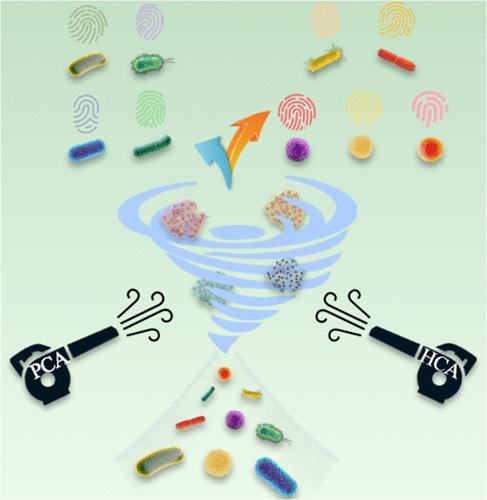基于四种具有过氧化氢酶样活性的dna纳米酶的压力传感器阵列用于便携式多重检测食源性病原体
IF 6.2
1区 农林科学
Q1 AGRICULTURE, MULTIDISCIPLINARY
引用次数: 0
摘要
本研究开发了一种基于四种具有过氧化氢酶样活性的功能化dna纳米酶的压力传感器阵列,用于便携式压力计对食源性病原体的多重检测。得益于4-巯基苯基硼酸和β-巯基乙胺的功能化,4种dna纳米酶与9种细菌之间的非特异性相互作用的多样性通过催化H2O2产生独特的“指纹”,导致压力响应模式的差异。主成分分析和层次聚类分析是处理多变量数据的有效统计工具,通过分析压力响应模式来鉴定9种食源性病原体。此外,所制备的传感器阵列可以区分不同的细菌混合物并实现定量检测,对革兰氏阳性菌和革兰氏阴性菌的平均检出限分别为102和104 CFU mL-1,表明其具有良好的实用性和令人满意的实际样品检测精度。这项研究扩大了对食品安全监测中食源性病原体的多重分析的见解。本文章由计算机程序翻译,如有差异,请以英文原文为准。

Pressure Sensor Array Based on Four DNA-Nanoenzymes with Catalase-like Activity for Portable Multiple Detection of Foodborne Pathogens
This study has developed a pressure sensor array based on four functionalized DNA-nanoenzymes with catalase-like activity for multiple detections of foodborne pathogens through a portable pressure manometer. Benefiting from functionalization of 4-mercaptophenylboronic acid and β-mercaptoethylamine, the diversity of nonspecific interactions between four DNA-nanoenzymes and each of the nine bacteria leads to differences in pressure response patterns by catalyzing H2O2 to generate exclusive “fingerprints”. As effective statistical tools for processing multivariate data, principal component analysis and hierarchical clustering analysis are employed to identify nine foodborne pathogens by analyzing pressure response patterns. Furthermore, the as-prepared sensor array can discriminate different mixtures of bacteria and achieve quantitative detection, with an average detection limit of 102 and 104 CFU mL–1 for Gram-positive and Gram-negative bacteria, respectively, demonstrating its desirable practicality and satisfactory accuracy for real sample detection. This study expands insights into multiple analyses of foodborne pathogens for food safety monitoring.
求助全文
通过发布文献求助,成功后即可免费获取论文全文。
去求助
来源期刊
CiteScore
9.90
自引率
8.20%
发文量
1375
审稿时长
2.3 months
期刊介绍:
The Journal of Agricultural and Food Chemistry publishes high-quality, cutting edge original research representing complete studies and research advances dealing with the chemistry and biochemistry of agriculture and food. The Journal also encourages papers with chemistry and/or biochemistry as a major component combined with biological/sensory/nutritional/toxicological evaluation related to agriculture and/or food.

 求助内容:
求助内容: 应助结果提醒方式:
应助结果提醒方式:


